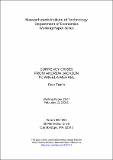| dc.contributor.author | Temin, Peter | |
| dc.date.accessioned | 2013-03-09T00:39:53Z | |
| dc.date.available | 2013-03-09T00:39:53Z | |
| dc.date.issued | 2013-02-13 | |
| dc.identifier.uri | http://hdl.handle.net/1721.1/77610 | |
| dc.description.abstract | This paper presents a narrative of currency crises for the past two centuries. I use the Swan Diagram as a theoretical framework for this narrative and conclude that many so-called banking crises are in fact currency crises. These crises are caused by capital flows in war and peace and typically result in recessions. The Swan Diagram helps us to consider external and internal imbalances together and understand their interactions. It also reminds us that national histories often ignore the international aspect of economic crises. This paper draws on and extends work reported in Peter Temin and David Vines, The Leaderless Economy, Why the World Economic System Fell Apart and How to Fix It (Princeton, 2013). | en_US |
| dc.publisher | Cambridge, MA: Department of Economics; Massachusetts Institute of Technology | en_US |
| dc.relation.ispartofseries | Working paper, Massachusetts Institute of Technology, Dept. of Economics;13-07 | |
| dc.rights | An error occurred on the license name. | en |
| dc.rights.uri | An error occurred getting the license - uri. | en |
| dc.subject | currency crises | en_US |
| dc.subject | Swan diagram | en_US |
| dc.subject | international trade | en_US |
| dc.subject | capital flows | en_US |
| dc.title | Currency Crises from Andrew Jackson to Angela Merkel | en_US |
| dc.type | Working Paper | en_US |
